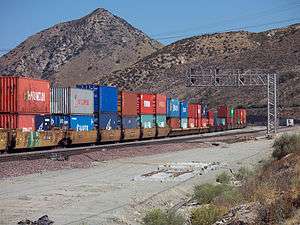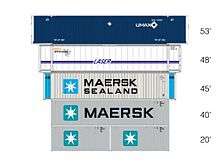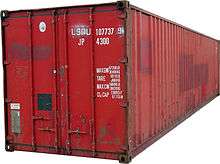Double-stack rail transport


Double-stack rail transport is a form of intermodal freight transport where intermodal containers are stacked two high on railroad cars. Introduced in North America in 1984, double stack has become increasingly common there, being used for nearly 70% of United States intermodal shipments. Using double stack technology, a freight train of a given length can carry roughly twice as many containers, sharply reducing costs per container. On most North American railroads, special well cars are used for double-stack to reduce the needed vertical clearance and to lower the center of gravity of a loaded car. In addition, the well car design significantly reduces damage in transit and provides greater cargo security by cradling the lower containers so their doors cannot be opened. A succession of larger container sizes have been introduced to further increase shipping productivity on shipments within North America.
Double-stack rail operations are growing in other parts of the world, but are often constrained by clearance and other infrastructure limitations.
Weights
Containers have weight limits designed to fit road trucks, which have clearly smaller weight limits than trains. A common limit for railways is 8 tonnes (7.9 long tons; 8.8 short tons) per meter train length and 22.5 tonnes (22.1 long tons; 24.8 short tons) per axle. A four axle container car can take 90 tonnes (99.2 short tons; 88.6 long tons). Since a container is limited to 30.5 tonnes (33.6 short tons; 30.0 long tons) (plus a rail car), single stacking clearly does not use the load capacity of the railway. A 20-foot (6.1 m) container is limited to 24 tonnes (26.5 short tons; 23.6 long tons) and two such can fit into a car for a 40-foot (12.2 m) container, or even three if double-stacking, but not four unless very high axle load is permitted. The North American railways permit two 53-foot (16.15 m) or four 20-foot (6.1 m) containers as shown in the images on this page.
Another consideration is the maximum weight of a train. A maximum length train in Europe, 750 m (2,461 ft) long can have 50 container cars with a total weight of 2,250 tonnes (2,480 short tons; 2,210 long tons), and more if 20 ft containers are included. This is not so far from the limit using standard European couplers. Double-stacking requires allowing higher train weight to be meaningful, since it is higher train weights that saves costs. In the U.S., the AAR coupler used allows much higher train weight.
Sizes and clearances
Double-stack cars come in a number of sizes, related to the standard sizes of the containers they are designed to carry. Well lengths of 40 ft (12.19 m), 48 ft (14.63 m) and 53 ft (16.15 m) are most common.[1] Heights range from 8 ft (2.44 m) to 9 ft 6 in (2.9 m) ("high cube").
Double stack requires a higher clearance above the tracks, or structure gauge, than do other forms of rail freight. Double-stack cars are most common in North America where intermodal traffic is heavy and electrification is less widespread; thus overhead clearances are typically more manageable. Nonetheless, North American railroads have invested large sums to raise bridges and tunnel clearances along their routes and remove other obstacles to allow greater use of double stack trains and to give them more direct routes.
CSX lists three clearance heights above top of rail for double stack service:[2]
- Doublestack 1 — 18 ft 2 in (5.54 m)
- Doublestack 2 — 19 ft 2 in (5.84 m)
- Doublestack 3 — 20 ft 2 in (6.15 m)
The last clearance offers the most flexibility, allowing two high cube containers to be stacked.
International and domestic stack trains in North America
Intermodal containers shipped by rail within in North America are primarily 53 foot long, with trailer-on-flat-car (TOFC) units used as well. This reflects a common maximum length for highway semi-trailers, which varies by state.[3] Major domestic intermodal carriers include: (these companies don't own a single 40 foot container)
- JB Hunt
- Swift
- Schneider National
- Hub Group
Containers shipped between North America and other continents consist of mostly 40's and some 45's and 20 footers. Container ships only take 40's, 20's and also 45's above deck. 90% of the containers that these ships carry are 40 footers and 90% of the worlds freight moves on container ships so 80% of the worlds freight moves via 40 foot containers. Most of these 40 foot containers are owned by non-U.S. companies like Maersk, MSC, and CMA CGM. The only U.S. 40 foot container companies are leasing companies like Textainer, Triton, and CAI.
History
Southern Pacific Railroad (SP), along with Malcom McLean, devised the double-stack intermodal car in 1977.[4][5] SP then designed the first car with ACF Industries that same year.[6][7] At first it was slow to become an industry standard, then in 1984 American President Lines, started working with the Union Pacific Railroad and that same year, the first all double-stack train left Los Angeles, California for South Kearny, New Jersey, under the name of "Stacktrain" rail service. Along the way the train transferred from the UP to the Chicago and North Western Railway and then to Conrail.
Double stack projects built or proposed in North America
Low bridges and narrow tunnels in various locations prevent the operation of double-stack trains until costly upgrades are made. Some Class I railroad companies in the U.S., often in partnership with government agencies, have initiated improvement programs to remove obstructions to double-stack trains. Double-stack projects include:
- Heartland Corridor (Norfolk Southern Railway) — $320 million[8]
- Norfolk Southern Crescent Corridor — $2.5 billion (estimate)
- National Gateway (CSX Transportation) — $700 million [9]
- Commonwealth Railway — $69 million[10]
- Chicago Region Environmental and Transportation Efficiency Program — $3 billion (estimate)
- Cross-Harbor Rail Tunnel proposed to connect rail freight lines in New Jersey with Long Island, New York. — $4–8 billion (estimate)
- Continental Rail Gateway (Canadian Pacific Railway), proposed tunnel between Detroit, Michigan and Windsor, Ontario to replace the existing Michigan Central Railway Tunnel. — $400 million[11]
Stacking containers

40 foot containers are the standard unit length, where all the stacking/ load bearing is. 45's, 48's, 53's all stack at the 40' coupling width. 40 foot containers or larger can be stacked on 20's if there are two 20's in a row (40' coupling width), however 20's can't be stacked on top of 40's or any other larger container. The possible double stacking patterns are:
- Two 20's in lower and one 40 (or longer) in upper stack (Allowed in India, China)
- One 40 in lower and another 40 (or longer) in upper stack (Allowed in India)
- Two 20's in lower and another set of two 20s in upper stack (possible in well type wagons, where ?)
The coupling holes are all female and it takes a double male twistlock to securely mate container stacks together.
Outside North America
Europe has more restricted loading gauge and train weight limits, so there is no operation of double-stack wagons so far.
Since electrification generally predated double stacking in Europe and New Zealand, the overhead catenary is too low to accommodate it. Many bridges and tunnels are too low for double-stacking, by far too expensive to rebuild for this reason. However, India is building some freight-only corridors with the overhead wiring at 7.45 m (24.4 ft) above rail, which is high enough.[12] In India (passenger), Pakistan (passenger), Finland, Russia, and Kazakhstan, 25 kV AC overhead wiring is at 6.5 m (21 ft) above rail.
Because of the broad gauge used in India and Pakistan, trains can carry standard shipping containers double-stacked on standard flat wagons, which is more economical than single containers, but standard gauge railways in North America and elsewhere must use special double-stack cars or well wagons to lower the center of gravity [13] and reduce the loading gauge. Indian Railways is able to carry containers double-stacked on standard flat wagons at 100 km/h (62 mph). (Triple-stacked operation with lower, 6-foot-6-inch (1,981 mm) containers, was mooted without success in 2006 [14]). Flatbeds, in addition to being much less expensive than well wagons, can carry more containers in a given length of train.[15][16] Experiments for double stacking under 25 kV AC overhead lines have begun because of funds given by Japan.[17][18]
-
 Australia - double-stacked trains operate between Perth, Adelaide, Darwin and Parkes, New South Wales[19] 6.5 m (21 ft) clearances [20]
Australia - double-stacked trains operate between Perth, Adelaide, Darwin and Parkes, New South Wales[19] 6.5 m (21 ft) clearances [20] -
 China - using double-stacked container trains under 25 kV AC overhead lines.[15]
China - using double-stacked container trains under 25 kV AC overhead lines.[15] -
 India - Mundra Port and Pipavav Port operate double-stacked diesel trains on 1,676 mm (5 ft 6 in) gauge using flat wagons.[15] It is one of only three countries to commercially double stack 9 ft 6 in (2,896 mm) tall (high cube) containers on a train.[21] India is building Dedicated Freight Corridor, economical and environmental friendly electrical traction based double-stack freight railway network which can transport international standard containers, a first in the world.[22]
India - Mundra Port and Pipavav Port operate double-stacked diesel trains on 1,676 mm (5 ft 6 in) gauge using flat wagons.[15] It is one of only three countries to commercially double stack 9 ft 6 in (2,896 mm) tall (high cube) containers on a train.[21] India is building Dedicated Freight Corridor, economical and environmental friendly electrical traction based double-stack freight railway network which can transport international standard containers, a first in the world.[22] -
 Netherlands - The Betuweroute, a freight rail between Rotterdam to the German border built 2007 is prepared for double-stacking insofar that tunnels are being built to accommodate double stack trains to reduce the cost and time of any future upgrade to the network.[23] The current catenary wire is too low for double stack rail transport and the upgrade is dependent on the German section of the railway connection.
Netherlands - The Betuweroute, a freight rail between Rotterdam to the German border built 2007 is prepared for double-stacking insofar that tunnels are being built to accommodate double stack trains to reduce the cost and time of any future upgrade to the network.[23] The current catenary wire is too low for double stack rail transport and the upgrade is dependent on the German section of the railway connection. -
 Panama - The rebuilt Panama Canal Railway operates double-stack container trains 47.6 miles (76.6 km) across the Isthmus of Panama from Colón on the Atlantic Ocean, to Balboa on the Pacific, near Panama City.
Panama - The rebuilt Panama Canal Railway operates double-stack container trains 47.6 miles (76.6 km) across the Isthmus of Panama from Colón on the Atlantic Ocean, to Balboa on the Pacific, near Panama City. -
 Saudi Arabia - Saudi Railways Organization line to Dammam.[24]
Saudi Arabia - Saudi Railways Organization line to Dammam.[24]
References
- ↑ Guide to Railcars Archived March 8, 2011, at the Wayback Machine.
- ↑ CSX System Clearance Map— Doublestack Routes
- ↑ http://ops.fhwa.dot.gov/freight/freight_analysis/nat_freight_stats/docs/04factsfigures/table3_6.htm
- ↑ Cudahy, Brian J., - "The Containership Revolution: Malcom McLean’s 1956 Innovation Goes Global". - TR News. - (c/o National Academy of Sciences). - Number 246. - September–October 2006. - (Adobe Acrobat *.PDF document)
- ↑ Chronological History - Union Pacific Railroad Company
- ↑ Kaminski, Edward S. (1999). - American Car & Foundry Company: A Centennial History, 1899–1999. - Wilton, California: Signature Press. - ISBN 0963379100
- ↑ "A new fleet shapes up. (High-Tech Railroading)". - Railway Age. - (c/o HighBeam Research). - September 1, 1990
- ↑ "Norfolk Southern opens Heartland Corridor". Railway Gazette International. 9 September 2010.
- ↑ "CSX Announces National Gateway to Improve Flow of Freight". CSX. 1 May 2008.
- ↑ http://trn.trains.com/en/Railroad%20News/News%20Wire/2010/12/New%20Commonwealth%20Railway%20line%20set%20to%20open.aspx
- ↑ Rail tunnel awaiting government funds
- ↑ "Reaching up". Railway Gazette International. August 2009. p. 17.
- ↑ Low center of gravity Archived March 21, 2011, at the Wayback Machine.
- ↑ Indian Express
- 1 2 3 Das, Mamuni (October 15, 2007). "Spotlight on double-stack container movement". The Hindu Business Line. Retrieved 2009-02-25.
- ↑ Das, Mamuni (October 29, 2007). "Green signal for triple-stacks on diesel routes". The Hindu Business Line. Retrieved 2009-03-15.
- ↑ http://www.irfca.org/gallery/openline/IRJ.jpg.html
- ↑ Preparing to handle double-stack containers, Raghu Dayal, Railway Gazette International May 2009, p46
- ↑ "Double stacked to Perth". Parkes Champion Post. 28 July 2008.
- ↑ http://www.artc.com.au/library/RIS_2.2.pdf
- ↑ "Double-decker container train arrives at Mundra". 18 April 2009.
- ↑ http://dfccil.org/dfccil_app/Salient_features.jsp
- ↑ "The Betuweroute solution". 1 April 2004. Retrieved 2011-07-22.
- ↑ https://www.youtube.com/watch?v=15-9UZJgLj4&index=3&list=PLDFJyRVlEItf43ECwr2gSrvJmsRXJ-4mV
